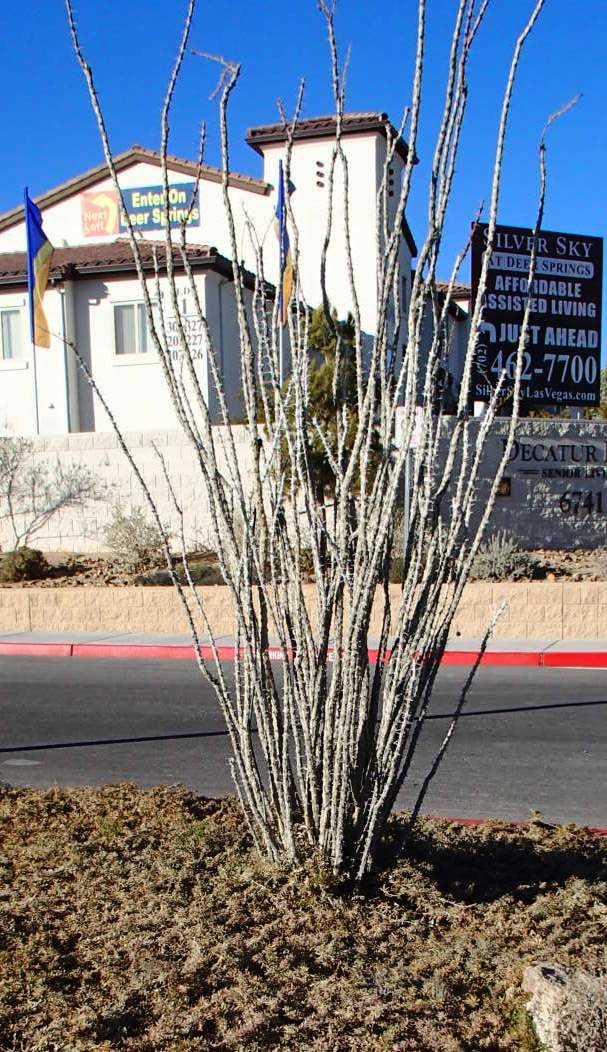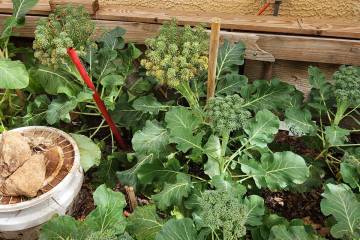Research online before selecting landscape plants
There are many plants to choose from when landscaping your home. But which will perform best? How and where should they be grown in your yard?
Landscape plants can be chosen from your local nurseries and garden centers and will, for the most part, grow well in our desert environment. Your job is to choose the right-size plant, put it in the best location and amend the soil where it is growing.
That may take two trips. The first is just to gather information, take this information home and investigate your choices. Your second trip is to buy the plants and proper soil amendments.
Your first selection criterion is winter hardiness. The information can be found online.
Major trees and shrubs important to your landscape should withstand temperatures to 20 degrees during the winter months for their long-term health and survivability. Plants that can be lost or damaged in the landscape should tolerate winter temperatures to 25 degrees. If you want to experiment and have some fun with plants, select plants that don’t handle any freezing temperatures at all.
Plant size is another decision. You can reasonably reduce the size of a plant to about two-thirds of its mature height and width. That takes work and expense on your part as it gets older. It’s best to choose a plant that is closer to the right size at the very beginning.
Another factor is landscape location. Some plants tolerate the hotter western and southern exposures. Plants that perform best in these hot, dry and isolated locations frequently originate from hot, desert climates in the Southwest deserts: Chihuahuan, Sonoran, Mojave and Great Basin.
Other plants will struggle in these locations and should be planted in eastern or northern exposures. Again, online research helps you in this decision.
Some plants grow well for many years surrounded by rock. Others may grow there OK for a few years and then start to suffer. Plants from places like the East Coast, Asia or tropical areas should be surrounded by wood chips rather than rock for long-term health and well-being.
Select three plants for each location before you do your online research. Online databases from the Southern Nevada Water Authority and Arizona State University are good places to start. You can contact me for more help if you need it.
Q: I moved here a year ago and have yet to figure out what my palm tree needs to thrive. It gets plenty of water. I located and uncovered the drippers to make sure it was getting enough water and even moved some plants away from it so it got more water.
A: Palm trees growing in the desert are oasis plants; they need to grow near water but not in it. They like to be surrounded by other plants that also need water.
A big mistake to make with palm trees is to grow them alone, out in the middle of nowhere and surround them with rock. Growing them alone, in full sun and surrounding them with rock is asking for a multitude of different problems.
A second problem with most palms is their mature size. They are cute to look at when small, but all of the palms get larger as they get older. Their growing size forces homeowners to pay more for pruning and possibly removal, as these trees get larger.
Probably the two palms that are the best choices for smaller residential landscapes are the windmill palm and Mediterranean fan palm. The Mediterranean fan palm can be put into hot windy locations but requires pruning as it gets older. The pruning mostly focuses on keeping it from getting wider.
The second choice is the slow-growing windmill palm. Windmill palm should be placed on the east or north side of a landscape out of the wind. Both should be surrounded by other plants and wood chips rather than rock.
Q: I live in the Anthem community at 2,900 feet and have a large variety of plants watered with drip emitters. I typically fertilize three times a year with a local nursery product. I also apply EDDHA iron chelate as needed if a shrub shows signs of yellowing. Comments?
A: Mineral fertilizers for home landscapes are all the same, whether you get them from a local nursery or not. I select a mineral fertilizer based upon the price and the three numbers on the outside of the bag.
The last of the three numbers, potassium, should always be high. The first number, nitrogen, encourages growth and greening of the plant and disappears with watering. The middle number, phosphorus, encourages flowering, rooting and sticks around in the soil longer after an application. If there is any fertilizer needed by plants later in the year, it’s the first number, nitrogen.
One application of fertilizer in the early spring of each year is all that is required for most landscape plants. Exceptions are lawns, vegetables and show plants like roses that produce a show of flowers to enjoy. Even fruit trees grow well with one application of fertilizer in the spring of each year. Winter-tender plants, like most citrus and bougainvillea, are fertilized only once in the early spring, avoiding fertilizer applications after the middle of summer.
All that being said, it’s always best to repeat applications of fertilizer in small amounts all through the growing season. It’s not necessary, but according to research, it’s best.
For plants that like continuous feedings such as vegetables and show plants, I like to use rich compost as a fertilizer at the beginning of the year and then follow up with very light nitrogen applications for the remainder of the year when needed.
Q: My backyard has several planting beds containing roses, rosemary, mock orange, euonymus, pyracantha, lantana, sago palms and other plants. I added rock to the soil surface eight years ago, and these plants started to decline in about five years. I decided to remove the rock and put wood chips down instead but am afraid of roaches entering the house from the wood chips.
A: Insects such as cockroaches like water and something to eat. They live in the wood chips exposed to water because they help break down debris from the wood chips.
Cockroaches, unpleasant as they are, are decomposers. Their favorite place to congregate in the landscape is in irrigation boxes where it stays wet. They are attracted to these wet areas and warmth of your home when it gets cold, so they may come inside as their populations get larger.
Keep landscape areas close to the home dry. Apply water to landscape plants no closer than 3 feet from your house’s exterior walls. There isn’t a good reason to apply water closer than this.
In a desert climate, where there is limited rainfall, plant roots follow irrigation water. Irrigating foundation plants on the side away from the home causes their roots to grow in that direction. Keeping the soil dry surrounding your home also reduces water damage to the cement as well as reducing insect problems inside the home.
After removing the rock and before you apply wood chips, sprinkle the wet areas around plants with a rich compost to help feed the plants, enrich the soil and start the decomposition process.
Q: We have two 12-year-old Texas sage shrubs concealing the street mailboxes. Within a month this past summer, they were dying back rapidly. The dieback spread over both plants. The irrigation hasn’t changed. Any idea what could be causing this?
A: My explanation follows the KISS principle. Texas sage, a Chihuahuan desert native, has roots that die if watered too often. If the main stem or trunk of this shrub stays wet, that could cause it to die.
My guess is that this is a trunk/root disease caused by watering too often. This disease moves with irrigation water and can spread easily between nearby plants.
When first planted, the drip emitters must be close to the plant. They should be moved and more drip emitters added as the plant gets larger.
That practice does not change the irrigation frequency but changes how much water is applied and where it is applied. A larger area under the plant is watered to compensate for its increased size.
Move the drip emitters away from the trunk or main stem to a distance of 1 foot from its trunk. That should be done when the shrub is 3 to 4 years old.
At the same time, add more drip emitters and redistribute the emitters so that they irrigate half the area under the enlarged plant canopy. That gives the plant more water, distributes the water to a larger area because it’s larger and reduces the chance of trunk/root diseases of susceptible plants.
Bob Morris is a horticulture expert and professor emeritus of the University of Nevada, Las Vegas. Visit his blog at xtremehorticulture.blogspot.com. Send questions to Extremehort@aol.com.























